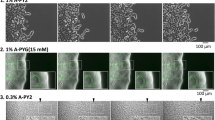Abstract
Mutants of Asticcacaulis biprosthecum lacking the ability to attach to various surfaces were selected by serial transfer in liquid media containing cheesecloth, to which wild-type cells attach but holdfast mutants do not. Congo red, incorporated into solid media, distinguishes between colonies of wild-type cells and those of holdfast mutants. Holdfast mutants were characterized and compared to wild-type cells according to their ability to swim, to attach to each other or to wild-type cells, for the presence on the cells of polar surface structures (holdfast, flagella, pili), and for sensitivity to phages. All holdfast mutants produced flagella, even though some mutants were nonmotile. Eighteen holdfast mutants fell into two groups: those apparently defective only in holdfast function and those defective in additional structures localized at the holdfast pole of the cell. None of these holdfast mutants was defective in prosthecal development. All holdfast mutants are capable of forming rosettes with wild-type cells, even though they are incapable of initiating attachment on their own, suggesting polymeric bridging as a likely mechanism for attachment.
Similar content being viewed by others
Abbreviations
- PYE:
-
peptone-yeast extract
References
Adams, M. H.: Bacteriophages. New York: Interscience 1959
Adelberg, E. A., Mandel, M., Chen, G., Chan Cheng: Optimal conditions for mutagenesis by N-methyl-N′-nitro-N-nitro-soguanidine in Escherichia coli K12. Biochem. Biophys. Res. Comm. 18, 788–795 (1965)
Agabian-Keshishian, N., Shapiro, L.: Stalked bacteria: properties of deoxyribonucleic acid bacteriophage ϕCbK. Virology 5, 795–800 (1970)
Agabian-Keshishian, N., Shapiro, L.: Bacterial differentiation and phage infection. Virology 44, 46–53 (1971)
Fletcher, M., Floodgate, G. D.: An electron-microscopic demonstration of an acidic polysaccharide involved in the adhesion of a marine bacterium to solid surfaces. J. Gen. Microbiol. 74, 325–334 (1973)
Fukuda, A., Iba, H., Okada, Y.: Stalkless mutants of Caulobacter crescentus. J. Bacteriol. 131, 280–287 (1977)
Fukuda, A., Miyakawa, K., Iida, H., Okada, Y.: Regulation of polar surface structures on Caulobacter crescentus: pleiotropic mutations affect the coordinate morphogenesis of flagella, pili and phage receptors. Molec. Gen. Genet. 149, 167–173 (1976)
Harris, R. H., Mitchell, R.: The role of microbial polymers in microbial aggregation. Ann. Rev. Microbiol. 27, 27–50 (1973)
Kurn, N., Ammer, S., Shapiro, L.: A pleitropic mutation affecting expression of polar events in Caulobacter crescentus. Proc. Natl. Acad. Sci. U.S.A. 71, 3157–3161 (1974)
Lagenaur, C., Farmer, S., Agabian, N.: Adsorption properties of stage-specific Caulobacter phage ϕCbK. Virology 77, 401–407 (1977)
Luft, J. H.: Ruthenium red and ruthenium violet. I. Chemistry, purification, methods of use for electron microscopy and mechanism of action. Anat. Rec. 171, 347–348 (1971)
Marino, W. S., Ammer, S., Shapiro, L.: Conditional surface structure mutants of Caulobacter crescentus. Temperature-sensitive flagella formation due to an altered flagellin monomer. J. Mol. Biol. 107, 115–130 (1976)
Middleton, C. A., Pate, J. L.: Isolation and partial characterization of some new bacteriophages active against Asticcacaulis strains. Int. J. Syst. Bacteriol. 26, 269–277 (1976)
Ottow, J. C. G.: Ecology, physiology, and genetics of fimbriae and pili. Ann. Rev. Microbiol. 29, 79–108 (1975)
Pate, J. L., Ordal, E. J.: The fine structure of two unusual stalked bacteria. J. Cell Biol. 27, 133–150 (1965)
Pate, J. L., Ordal, E. J.: The fine structure of Chondrococcus columnaris: III. The surface layers of Chondrococcus columnaris. J. Cell Biol. 35, 37–51 (1967)
Poindexter, J. L.: Biological properties and classification of the caulobacter group. Bacteriol. Rev. 28, 231–295 (1964)
Poindexter, J. L. S., Cohen-Bazire, G.: The fine structure of stalked bacteria belonging to the family Caulobacteraceae. J. Cell Biol. 23, 387–607 (1964)
Reynolds, E. S.: The use of lead citrate at high pH as an electronopaque stain in electron microscopy. J. Cell Biol. 17, 208–212 (1963)
Schmidt, J. M.: Observations on the adsorption of Caulobacter bacteriophages containing ribonucleic acid. J. Gen. Microbiol. 45, 347–358 (1966)
Stove, J. L., Stanier, R. Y.: Cellular differentiation in stalked bacteria. Nature 196, 1189–1192 (1962)
Author information
Authors and Affiliations
Rights and permissions
About this article
Cite this article
Umbreit, T.H., Pate, J.L. Characterization of the holdfast region of wild-type cells and holdfast mutants of Asticcacaulis biprosthecum . Arch. Microbiol. 118, 157–168 (1978). https://doi.org/10.1007/BF00415724
Received:
Issue Date:
DOI: https://doi.org/10.1007/BF00415724



